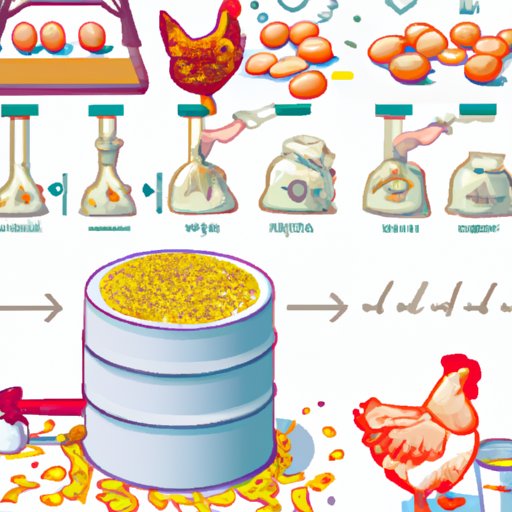Introduction
Raising chickens is an enjoyable and rewarding experience, but it’s important to understand the amount of money you are likely to spend on the project. Knowing the cost of raising chickens will help you make informed decisions when planning your poultry project.
The cost of raising chickens depends on a variety of factors including the type of chickens you choose, the size of the chicken coop, the cost of feed, and other supplies. In this article, we’ll discuss the financial investment of raising chickens and the ongoing expenses associated with keeping them.

Calculating the Cost of Raising Chickens
When calculating the cost of raising chickens, there are two main considerations: the initial financial investment and the ongoing expenses. The initial investment includes the cost of purchasing or building a chicken coop, buying feed and supplies, and any other upfront costs. The ongoing expenses include regular feed costs, vet bills, and other upkeep costs such as water and electricity.
The Financial Investment of Raising Chickens
The first step in calculating the cost of raising chickens is to consider the financial investment. The most significant initial expense is usually the cost of a chicken coop. Depending on the size and materials used, chicken coops can range from a few hundred dollars to several thousand dollars.
In addition to the cost of a chicken coop, you will also need to buy feed for your chickens. Feed typically costs between $10 and $20 per bag, depending on the type of feed you purchase. You may also need to buy additional supplies such as bedding, nesting boxes, waterers, and heat lamps.
What Are the Expenses of Keeping Chickens?
Once you have purchased the necessary supplies, you will need to consider the ongoing expenses associated with keeping chickens. These include regular feed costs, which will vary depending on the type and quantity of feed you purchase. You should also budget for occasional vet bills, as well as utilities such as water and electricity.

Understanding the Economic Impact of Raising Chickens
In addition to the costs associated with raising chickens, it’s important to consider the potential economic benefits. If you raise chickens for eggs, meat, or other products, you may be able to make a profit. Even if you don’t sell the eggs or meat, you may still save money on food costs by supplementing your diet with fresh eggs or meat from your own flock.

Estimating the Cost of a Chicken Coop
When estimating the cost of a chicken coop, the two main factors to consider are the size and materials used. Smaller chicken coops can range from a few hundred dollars to a few thousand dollars, while larger coops can cost up to several thousand dollars. The materials used will also affect the cost; wood is usually the least expensive option, while metal is more expensive.
How Much Does it Cost to Feed Chickens?
The cost of feeding chickens varies depending on the type of feed you purchase. Commercial feed is usually the most affordable option, while scratch grains and vegetables and fruits can be more expensive. You can also save money by growing your own feed or supplementing your chickens’ diet with foraged foods.
Conclusion
Raising chickens can be a rewarding experience, but it’s important to understand the costs associated with this venture. The initial financial investment includes the cost of a chicken coop, feed, and supplies. The ongoing expenses include regular feed costs, vet bills, and other upkeep costs such as water and electricity. When considering the economic impact of raising chickens, it’s important to factor in the potential profits from eggs, meat, or other products, as well as the potential savings from reduced food costs.
By understanding the cost of raising chickens, you can make informed decisions about your poultry project and ensure that you are prepared for the financial commitment involved.
(Note: Is this article not meeting your expectations? Do you have knowledge or insights to share? Unlock new opportunities and expand your reach by joining our authors team. Click Registration to join us and share your expertise with our readers.)
